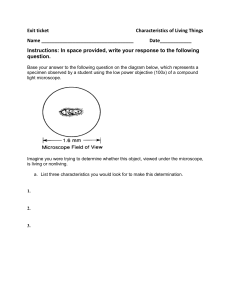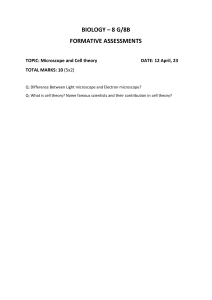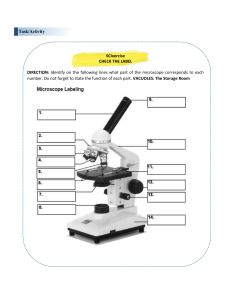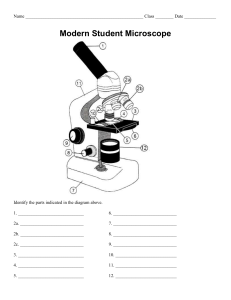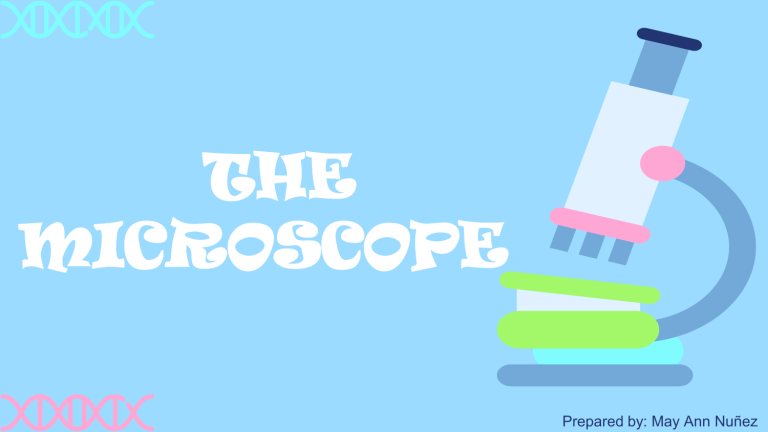
THE MICROSCOPE Prepared by: May Ann Nuñez DEFINITION What is a Microscope? MICROSCOPE • Comes from the Ancient Greek micros meaning “small” and skopein, which means “to look” • A tool which can help see tiny objects and organisms that are too small to be seen by the naked eye. Microscopy – the science of investigating small objects and structures using microscope What makes a microscope determine how clearly a small object can be viewed? Magnification – describes how much larger an object appears when viewed Total magnification= 𝑚𝑎𝑔𝑛𝑖𝑓𝑖𝑐𝑎𝑡𝑖𝑜𝑛 𝑝𝑜𝑤𝑒𝑟 𝑜𝑐𝑢𝑙𝑎𝑟 𝑙𝑒𝑛𝑠 𝑋 𝑝𝑜𝑤𝑒𝑟(𝑜𝑏𝑗𝑒𝑐𝑡𝑖𝑣𝑒 𝑙𝑒𝑛𝑠) Resolution or resolving power – the capacity of a microscope to distinguish finer details of an image TYPES OF MICROSCOPES 1. Optical microscope – uses visible light to form an image. It uses glass lenses to magnify and resolve images. Two Types: A. Compound – uses two or more double convex lenses to magnify the object; it can magnify object up to 1200x B. Stereomicroscope – also known as dissecting microscope; it magnifies the object 100x and gives three- dimensional image TYPES OF MICROSCOPES 2. Electron microscope – uses high energy electron beams to form an image. • Image form can be viewed from a photographic plate or computer screen • The image magnified can reach up to 2 000 000x Two Types: A. Transmission electron microscope (TEM) B. Scanning electron microscope (SEM) PARTS AND FUNCTIONS OF A MICROSCOPE Microscope is consist of three main parts which are grouped according to their functions. 1. Mechanical Parts – used to support and adjust other parts of the microscope a. Base b. Body tube c. Coarse adjustment knob d. Fine adjustment knob e. Stage f. Stage clip g. Revolving nosepiece PARTS AND FUNCTIONS OF A MICROSCOPE Microscope is consist of three main parts which are grouped according to their functions. 2. Illuminating Parts – used to regulate the amount of light towards the focus specimen a. Diaphragm b. Stage Condenser c. Mirror PARTS AND FUNCTIONS OF A MICROSCOPE Microscope is consist of three main parts which are grouped according to their functions. 3. Magnifying Parts – used to magnify or enlarge the image of the specimen in focus a. Eyepiece b. • • • • Objective lenses Scanner objective Low power objective High power objective Oil immersion objective PARTS AND FUNCTIONS OF A MICROSCOPE 1. Eyepiece or Ocular Lens – this is the part used to look through the microscope PARTS AND FUNCTIONS OF A MICROSCOPE 2. Body tube or Lens tube – it is connected with the eyepiece and its main task is to hold it PARTS AND FUNCTIONS OF A MICROSCOPE 3. Revolving nosepiece– it holds the objective lens. • It is movable and it can revolve the objective lenses depending on the magnification power of the lens PARTS AND FUNCTIONS OF A MICROSCOPE 4. Arm– this is the part connecting the base and the to the head, and the eyepiece tube to the base of the microscope. • It gives support to the head of the microscope and it is also used when carrying the microscope. PARTS AND FUNCTIONS OF A MICROSCOPE 5. Objectives/objective lenses – are the major lenses used for specimen visualization • Scanner – the shortest one marked 3x,4x,or 5x • Low Power Objective – is marked 10x or 12x • High Power Objective – is marked 40x, 43x or 60x PARTS AND FUNCTIONS OF A MICROSCOPE 6. Stage– is the platform that holds the specimen or sample for viewing. 7. Stage clips – hold the specimen slides in place. Stage Stage Clips PARTS AND FUNCTIONS OF A MICROSCOPE 8. Diaphragm – controls the amount of light that passes through the specimen PARTS AND FUNCTIONS OF A MICROSCOPE 9. Coarse adjustment knob – focuses images under the scanner and the low- power objectives. 10. Fine adjustment knob – focuses images under the high-power and oil immersion objectives PARTS AND FUNCTIONS OF A MICROSCOPE 11. Light source – provides light for the specimen (could be a lamp or a mirror) 12. Base – supports the microscope Light source Base Brief History of Microscope 1590 1625 1665 1674 1830 1872 • Hans and Zacharias Janssen • Galileo Galilei • Robert Hooke • Anton van Leeuwenhoek • Jackson Lister • Ernst Abbe 1903 • Richard Zsigmondy 1932 • Fritz Zernike Now • Charles Spencer • • • • 1000 AD – the first visionary aid was invented It was a glass sphere that magnified when laid on top of reading materials Known as Reading Stone Italian, Salvino D’amarte is credited with inventing the first wearable eyeglasses • 1590 – Two Dutch eye glass makers, Zaccharias Janssen and son Hans Janssen • Experimented with multiple lenses placed in a tube. The Janssens observed that viewed objects in front of the tube appeared greatly enlarged, creating both the forerunner of the compound microscope and the telescope • 1665 – The Discovery of “Cell” • English physicist, Robert Hooke look at a silver cork through a microscope lens and noticed some “pores” or “cells” in it. • 1674 – The Father of Microcopy • Created simple microscope to view blood, yeast, and insects. • Anton van Leeuwenhoek • 1830 – Joseph Jackson Lister reduces spherical aberration or the “chromatic effect” by showing that several weak lenses used together at certain distances gave good magnification without blurring the image. This was the prototype for the compound microscope Ernst Abbe • 1903 – Richard Zsigmondy developed the ultramicroscope that could study objects below the wavelength of light. • He won the Nobel Prize in Chemistry in 1925 • 1932 – Fritz Zernike invented the phasecontrast microscope that allowed for the study of colorless and transparent biological materials for which he won the Nobel Prize in Physics in 1953 1625 – Galileo Galilei invented one of the first compound microscope 1665 – Robert Hooke coined the term “cell” 1674 – Anton van Leeuwenhoek one of the first scientists able to observe bacteria movement in a single drop of pond water. 1830 – Joseph Jackson Lister was credited for his prototype of the compound microscope 1872 – Erns Abbe provided the calculations that allowed for the maximum resolution in microscopes possible 1903 – Richard Zsigmondy developed the ultra-microscope 1932 Frits Zernike invented the phase –contrast microscope 19th century – Charles Spencer began producing fine optical microscope
